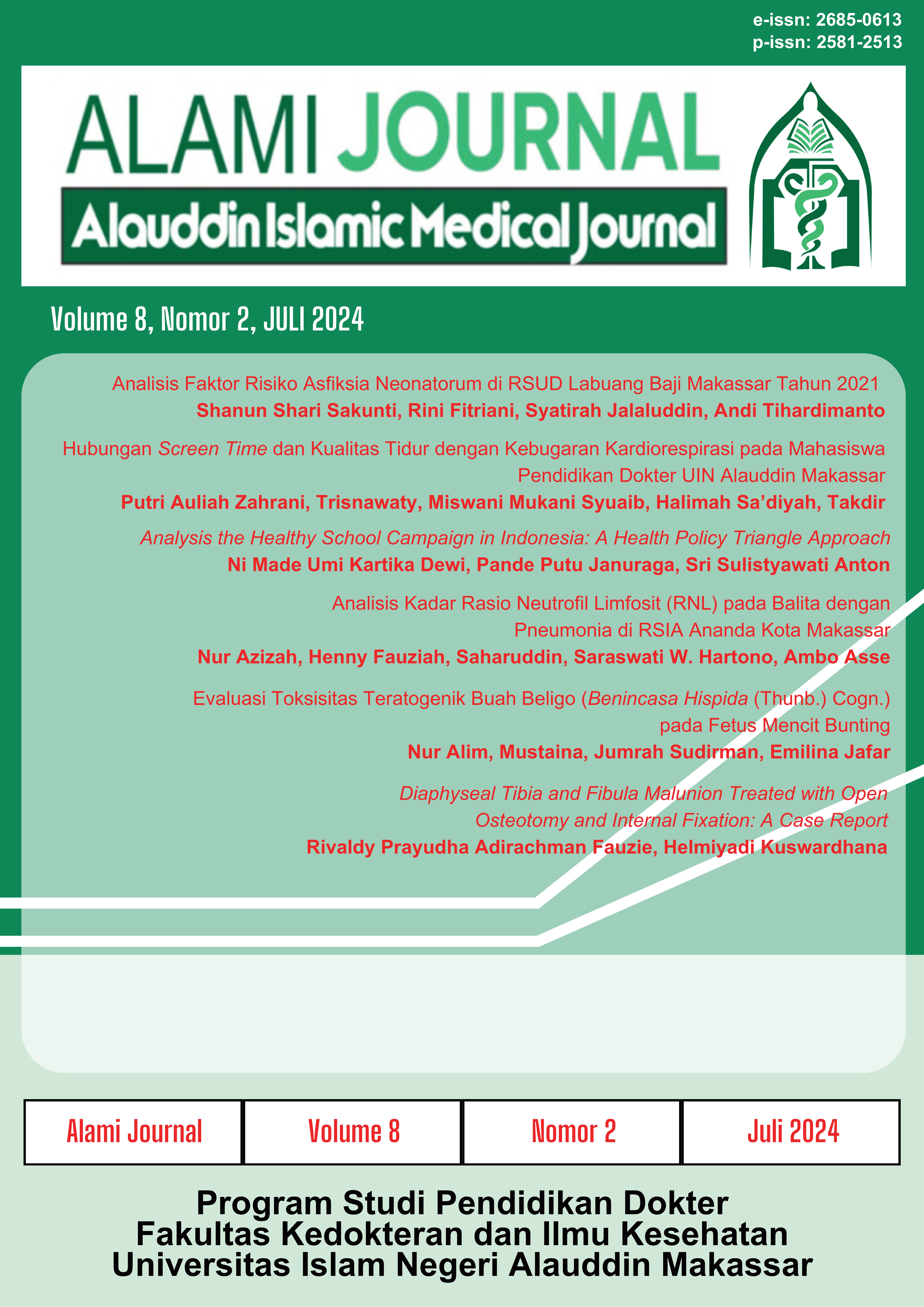Analisis Kadar Rasio Neutrofil Limfosit (RNL) pada Balita dengan Pneumonia di Rsia Ananda Kota Makassar
Abstrak
Kadar Rasio Neutrofil Limfosit (RNL), sebagai prediktor inflamasi yang diperoleh dari hasil bagi antara neutrofil absolut dengan limfosit absolut, menunjukkan adanya peningkatan pada berbagai penyakit yang memicu inflamasi terutama pada pneumonia dengan komplikasi dan tingkat mortalitas yang lebih tinggi. Tujuan dari penelitian ini adalah untuk menganalisis perbedaan kadar RNL pada balita dengan pneumonia dan balita dengan Infeksi Saluran Pernapasan Akut Atas/ISPA Atas yang bukan pneumonia di RSIA Ananda Kota Makassar. Penelitian ini menggunakan desain analitik observasional dengan pendekatan cross sectional. Sampel penelitian berjumlah 139 sampel dan berasal dari populasi balita (usia 12-59 bulan) yang dibagi menjadi sampel pneumonia dan bukan pneumonia (ISPA Atas) yang memiliki hasil pemeriksaan darah rutin dan data rekam medis yang lengkap. Analisis data menggunakan uji univariat dan bivariat (Independent T Test). Dalam penelitian ini, rerata RNL pada sampel pneumonia lebih rendah jika dibandingkan dengan bukan pneumonia (ISPA Atas) dan juga ditemukan tidak adanya perbedaan yang signifikan antara kadar RNL pada sampel pneumonia dan bukan pneumonia (ISPA Atas). Oleh karena itu, kesimpulan penelitian ini menunjukkan tidak adanya peningkatan yang bermakna pada RNL balita dengan pneumonia.
Referensi
Ebeledike C, Ahmad T. Pediatric Pneumonia Pathophysiology. Treasure Island: StatPearls Publishing; 2022.
Yuniamawati AD. Correlation between the Number of Leucocytes and Neutrophil to Lymphocytes Count Ratio in Children with Pneumonia at RSUD Koja Jakarta. Science Midwifery. 2022; 11(2): 8–13.
Kementrian Kesehatan RI. Profil Kesehatan Indonesia Tahun 2020. Jakarta: Menteri Kesehatan Republik Indonesia; 2021. 1–480 p.
Nguyen PTK, et al. Characterisation of Children Hospitalised with Pneumonia in Central Vietnam: A Prospective Study. European Respiratory Journal. 2019; 54(1): 1–10.
Wu J, et al. The Value of Lymphocyte-to-Monocyte Ratio and Neutrophil-to-Lymphocyte Ratio in Differentiating Pneumonia from Upper Respiratory Tract Infection (URTI) in Children: A Cross-Sectional Study. BMC Pediatrics. 2021; 21(1): 1–11.
Buonacera A, Stancanelli B, Colaci M, Malatino L. Neutrophil to Lymphocyte Ratio: An Emerging Marker of the Relationships between The Immune System and Diseases. International Journal of Molecular Sciences. 2022; 23(7): 3636.
Jiang J, et al. The Neutrophil-Lymphocyte Count Ratio as a Diagnostic Marker for Bacteraemia: A Systematic Review and Meta-Analysis. The American Journal of Emergency Medicine. 2019; 37(8): 1482–9.
Westerdijk K, et al. The Value of The Neutrophil-Lymphocyte Count Ratio in The Diagnosis of Sepsis in Patients Admitted to The Intensive Care Unit: A Retrospective Cohort Study. PLoS One. 2019; 14(2): 1–13.
Najm RA, AL-dujaili ANG, Hashim JM. Study of Procalcitonin and Neutrophil/ Lymphocyte Count Ratio in Children Infected with Community-Acquired Pneumonia. International Journal of Health Sciences. 2022; 6(1): 4218–32.
Puspanadi T. Prediktor Neutrophil-Lymphocyte Count Ratio (NLCR) Terhadap Tingkat Keparahan Pneumonia Pada Pasien Anak Di RSUD dr. Saiful Anwar Malang [Disertasi]. Malang: Universitas Brawijaya; 2019.
Fest J, et al. Reference Values for White Blood-Cell-Based Inflammatory Markers in The Rotterdam Study: A Population-Based Prospective Cohort Study. Scientific Reports. 2018; 8(1): 1–7.
Alon R, et al. Leukocyte Trafficking to The Lungs and Beyond: Lessons from Influenza for COVID-19. Nature Reviews Immunology. 2021; 21(1): 49–64.
Washburn ML, Crosby R, Remlinger K, Wang F, Creech D. Therapeutically Attenuating Neutrophil Recruitment with a CXCR2 Antagonist in Combination with Oseltamivir Ameliorates Influenza-Induced Lung Injury and Disease. Open Forum Infectious Diseases. 2019; 6(4): 4–7.
Cilloniz C, et al. Lymphopenia is Associated with Poor Outcomes of Patients with Community-Acquired Pneumonia and Sepsis. Open Forum Infectious Diseases. 2021; 8(6): 1–10.
Chen X, Yang L. A Systematic Review and Meta-Analysis of The Relationship Between T-Lymphocytes and Respiratory Tract Infection in Children. Advances in Clinical and Experimental Medicine. 2022; 32(3): 275-84.
Wang F, et al. Characteristics of Peripheral Lymphocyte Subset Alteration in Covid-19 Pneumonia. The Journal of Infectious Diseases. 2020; 221(11): 1762–9.
Gul A, et al. Peripheral Blood T Cells Response in Human Parainfluenza Virus-Associated Lower Respiratory Tract Infection in Children. Saudi Journal of Biological Sciences. 2020; 27(10): 2847–52.
Li H, et al. The Profile of Peripheral Blood Lymphocyte Subsets and Serum Cytokines in Children with 2019 Novel Coronavirus Pneumonia. Journal of Infection. 2020; 81(1): 115-20.
Cosgrove PR, et al. Characterizing T Cell Subsets in The Nasal Mucosa of Children with Acute Respiratory Symptoms. Pediatric Research. 2021; 90(5): 1023–30.
Calapodopulos NVI, et al. Association of Recurrent Upper Respiratory Tract Infections with Low Production of Oxygen Intermediates in Children. Jornal de Pediatria. 2022; 98(4): 399–405.
Mahmoudi S, et al. Effects of Coronavirus Disease 2019 (COVID-19) on Peripheral Blood Lymphocytes and Their Subsets in Children: Imbalanced CD4+/CD8+ T Cell Ratio and Disease Severity. Frontiers in Pediatrics. 2021; 9(1): 4–10.
Qi X, Dong Y, Lin X, Xin W. Value of Neutrophil to Lymphocyte Ratio, Platelet to Lymphocyte Ratio, and Red Blood Cell Distribution Width in Evaluating the Prognosis of Children with Severe Pneumonia. Evidence-Based Complementary and Alternative Medicine. 2021; 2021 (1): 1-8.
##submission.copyrightStatement##
##submission.license.cc.by-nc-sa4.footer##Once an article was published in the journal, the author(s) are: granted to the journal right licensed under Creative Commons License Attribution that allows others to share the work with an acknowledgement of the work's authorship. permitted to publish their work online in third parties as it can lead wider dissemination of the work. continue to be the copyright owner and allow the journal to publish the article with the CC BY-NC-SA license receiving a DOI (Digital Object Identifier) of the work.

